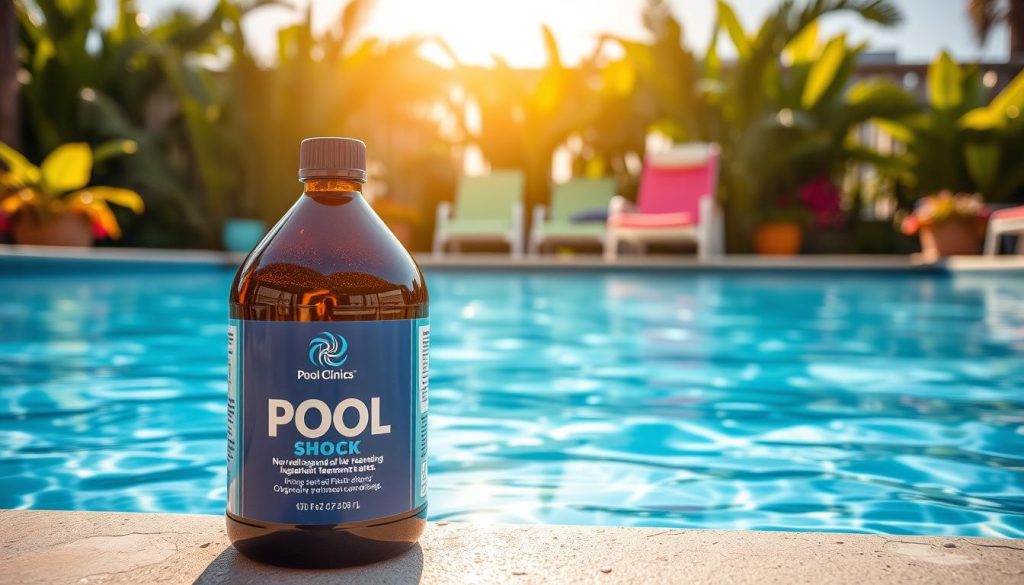
Shocking your pool is crucial for clean, safe swimming. It eliminates contaminants, bacteria, and algae. However, the process uses potent chemicals that can be risky if you swim too soon.
Understanding recommended wait times after shocking is vital for safety. Factors like shock type, pool size, and water volume affect waiting periods. Chlorine levels and pH balance also play a role.
Shock treatment is a key part of pool maintenance. It involves adding chemicals to clean the water. Different types of shock products are available for various needs.
Knowing when it’s safe to swim after shocking is important. We’ll explore factors that affect waiting times. We’ll also guide you on testing chlorine levels for safe swimming.
Key Takeaways
- Wait at least 24 hours after shocking a pool before swimming to ensure safety
- Factors like the amount and type of shock, pool size, and water volume affect wait times
- Test chlorine levels (1.0-4.0 ppm) and pH balance (7.2-7.8) before swimming
- Premature swimming in a shocked pool can cause skin and eye irritation, nausea, and vomiting
- Maintain proper pool chemistry, including pH, alkalinity, calcium hardness, and cyanuric acid levels
Understanding Pool Shock Treatment
Pool shock treatment keeps water clean and safe for swimmers. It involves adding concentrated chlorine to eliminate contaminants. Proper pool shock ensures good sanitization and optimal swimming conditions.
This process resets water quality. Pool owners can maintain their pools effectively by understanding shock treatment basics.
What is Pool Shock?
Pool shock is a powerful water treatment. It raises free chlorine levels to destroy harmful substances. These include bacteria, algae, and chloramines.
Chloramines form when chlorine mixes with contaminants like sweat. They cause unpleasant odors and irritation. Shocking oxidizes and removes these contaminants.
Why is Shocking a Pool Necessary?
Regular pool use leads to contaminant buildup. This includes sweat, urine, debris, and algae spores. These can make water dirty and cloudy.
Algae growth is a common issue. It’s unappealing and poses health risks. Algae can hide in crevices, making removal difficult.

Pool shocking rebalances chemical levels and eliminates pathogens. It raises chlorine to levels that destroy harmful substances. This ensures a hygienic swimming environment.
Types of Pool Shock Products
Several pool shock products are available. Each has unique characteristics and benefits. The most common types include:
- Calcium Hypochlorite (Cal-Hypo): A solid chlorine form widely used for pool shocking. It’s fast-acting and effective against contaminants and algae.
- Chlorinated Isocyanurates: These are stabilized chlorine forms. They provide a more sustained chlorine release over time.
- Chlorine-Free Shock: An alternative for those sensitive to chlorine. It oxidizes water and breaks down contaminants.
The shock type affects swim wait time and treatment effectiveness. Follow manufacturer instructions when using pool shock products. This ensures optimal results and safety.
Factors Affecting Wait Time After Shocking
Several key factors determine how long to wait before swimming after shocking your pool. These include the shock amount and type, pool size, and resulting chlorine levels. The waiting period for safe swimming depends on these factors.
Amount and Type of Shock Used
Chlorine dosage and shock product type affect waiting time before safe swimming. Non-chlorine options often allow quicker re-entry, sometimes within an hour. Traditional chlorine-based shocks typically require at least 12 hours, sometimes up to 24 or more.
Always follow manufacturer’s guidelines for dosage and waiting times. These can vary based on shock treatment potency. A general rule is to wait about one hour per pound of shock added.
Pool Size and Water Volume
Your pool’s dimensions and gallon capacity influence wait time after shocking. Larger pools need more time for chemicals to reach safe levels. Pool depth and shape can affect shock treatment distribution and dilution.
| Pool Size | Water Volume (Gallons) | Recommended Wait Time |
|---|---|---|
| Small (12′ x 24′) | 8,600 – 13,500 | 12 – 24 hours |
| Medium (14′ x 28′) | 13,000 – 22,000 | 18 – 36 hours |
| Large (16′ x 32′) | 19,000 – 31,000 | 24 – 48 hours |
Chlorine Levels and pH Balance
Test chlorine levels and pH balance before swimming after shocking. Safe chlorine levels should be 1.0 to 4.0 parts per million (ppm). The ideal pH range for swimming is 7.2 to 7.8.
Balancing pool pH and alkalinity before shocking enhances treatment effectiveness. It can also reduce waiting time for safe swimming. Aim for these ranges:
- pH: 7.2 – 7.8 (ideal 7.4 – 7.6)
- Total Alkalinity: 80 – 120 ppm
- Calcium Hardness: 200 – 400 ppm
- Cyanuric Acid: 30 – 50 ppm
Understand these factors and monitor your pool’s chemical levels through regular testing. This ensures a safe and enjoyable swimming experience after shocking your pool.
How Long After Shocking Pool Can I Swim
After shocking your pool, wait at least 24 hours before swimming. This allows chlorine to dissipate and chemicals to work effectively. The wait time may vary based on shock type, pool size, and water conditions.
General Recommended Wait Times
Wait a minimum of 24 hours after shocking before swimming. This safety measure lets chlorine levels return to a safe range of 1.0 to 4.0 ppm. It also gives the shock treatment time to eliminate contaminants and restore water balance.
Testing Chlorine Levels for Safety
Before swimming, test the water’s chlorine levels and pH balance. Aim for chlorine levels between 1.0 and 4.0 ppm and a pH range of 7.2 to 7.8. Regular testing maintains a hygienic swimming environment and ensures properly balanced water.
Risks of Swimming Too Soon After Shocking
Swimming too soon after shocking can cause eye and skin irritation, leading to redness and itchiness. Ingesting overly chlorinated water may result in nausea and other gastrointestinal issues.
Prolonged exposure to high chemical levels can trigger respiratory problems and other health risks. Always follow recommended wait times and monitor your pool’s water chemistry for safe swimming.







